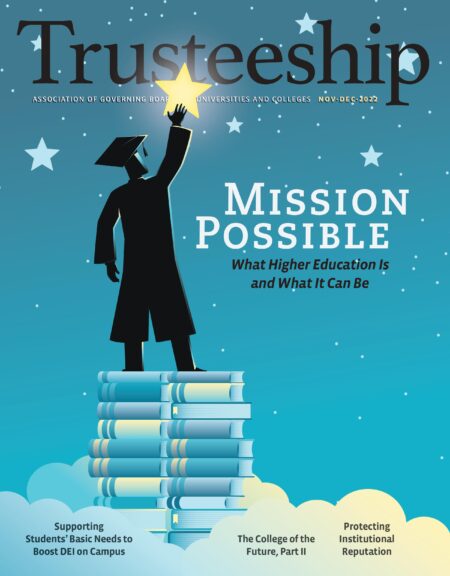
One only has to read the continuing headlines of the Chronicle of Higher Education or Inside Higher Education to see that many campus cultures are wounded. This woundedness is a result of a continuing pandemic and the essential pivot to virtual/hybrid learning; masking and isolation; the ghastly killing of George Floyd and the consequential demands and essential initiatives in response to the reality of continuing racial injustice; increasingly divisive partisan rhetoric about emergent issues such as critical race theory; and related freedom of speech and tenure issues. These issues are further complicated by numbers of students reportedly disengaged in the classroom or struggling with mental illness, leading faculty to create new ways of understanding teaching and learning. Finally, the financial stress on institutions, especially small, less prestigious institutions, has created “flight and fear” within institutions, resulting in the “great resignation” and “quiet quitting.” How did it come to this and what must be done to “reset” our institutions to create a sustainable pathway forward to rebuild and reestablish structures to support institutional and individual health.
What may have been traditionally understood as a common mindset for how people within a collegiate campus community do their jobs, interact, celebrate, and maintain a collective accountability (i.e. workplace expectations) has been altered. Many campuses are experiencing culture shock or an existential crisis—an organizational parallel to “long COVID” and “brain fog”—requiring new ways of understanding how to teach, mitigate, converse, convene, govern, prioritize and address problems. The lines that might normally define “rules of engagement” have become blurred or erased, requiring senior administrators and board members to learn new ways of working together, setting priorities, considering proactive modes of appreciation and employee-centric policies, allocating resources, and more.
Yet within these unprecedented challenges resides an opportunity (maybe even a moral imperative) to redefine or reaffirm the essential purpose and inherent values of one’s institution and what it means to lead with moral and ethical clarity, prudence, passion, perseverance, and creativity—all directed at promoting the common good.
Going forward, board members, in consultation with campus leaders might create very intentional conversations to engage some of the following questions:
1. What have been the traditional core values of one’s institution that deserve sustaining but have been compromised or abandoned in the context of recent realities, resulting in a lack of “practical presence”—and maybe a loss of competitive advantage in the marketplace?
2. Do campus leaders (often via the office of Human Resources) articulate a clear view of value-based workplace expectations and key capabilities and are those expectations and capabilities monitored, assessed, and rewarded when demonstrated? What new training may help to create a heightened awareness of high personal standards? In what ways can traditions, rituals, and other forms of meaning-making help to influence behavior?
3. Does the institutional budget reflect a serious commitment to reinforcing core values, workplace expectations, new models of teaching and learning, and recognition of the importance of health and wellness in a fractured environment?
4. Is there a clear vision for how to build up or scale institutional values and workplace expectations, shared accountability, and a commitment to deliberative dialogue? Who is responsible for such scaling in a shared governance environment?
5. Whose voices have been marginalized when defining campus culture and core values? What are the best practices to recover and integrate such voices?
Such a “reset” might begin with a strategic audit, SWOT or situational analysis, or a newly constructed strategic plan. Again, human resource departments may have to rethink training and create new ways of supporting employees. Deployment of resources may have to be reconsidered in light of newly understood realities. New administrative structures, fresh understandings of generational differences and political alignments, changes in personnel, and the development of new traditions and celebrations of work well done may need to happen. Also important is to find new ways of sharing a community’s stories, for stories are a community’s memory and “…when a community loses its memory, its members no longer know one another… If they do not know one another’s stories, how can they know whether or not to trust one another? People who do not trust one another do not help one another….”(1) All these new understandings and structures may help to create pathways to increase retention of faculty, staff, and students, improve satisfaction, and define more productive and authentic engagement at all levels.
Parker Palmer speaks of “living in a tragic gap” whereby the space “between what is and what could and should be, the gap between reality of a given situation and an alternative reality we know to be possible because we have experienced it.”(2)
Wounded institutions have a choice: to embrace the tension and realities of a new understanding or, as Palmer says, “….sink into a corrosive cynicism.” The test for many colleges during this challenging time of often combative transition will be the capacity to stand in the tension, to adopt what Palmer calls a “practical presence” that enlists all campus stakeholders in the effort to redeem a campus culture grounded in things that truly matter and values that endure, built upon trust and respectful strategies for change. Finding or reclaiming those institutional core values can lead to a source of grace, compassion, and forgiveness built upon high ideals of service and learning, forged by new circumstances and conscious choices that fill conflicted spaces with possibility and hope.
William Laramee is a trustee of Warren Wilson College and emeritus vice president for alumni and college relations at Berea College.
Endnotes
1 Wendell Berry, The Work of local culture, p. 157 in What are people for?
2 Parker Palmer, The Broken-Open Heart: Living with faith and hope in the tragic gap, Weavings: A Journal of the Christian Spiritual Life, March/April 2009, Vol XXIV:2, 2008, Nashville.


